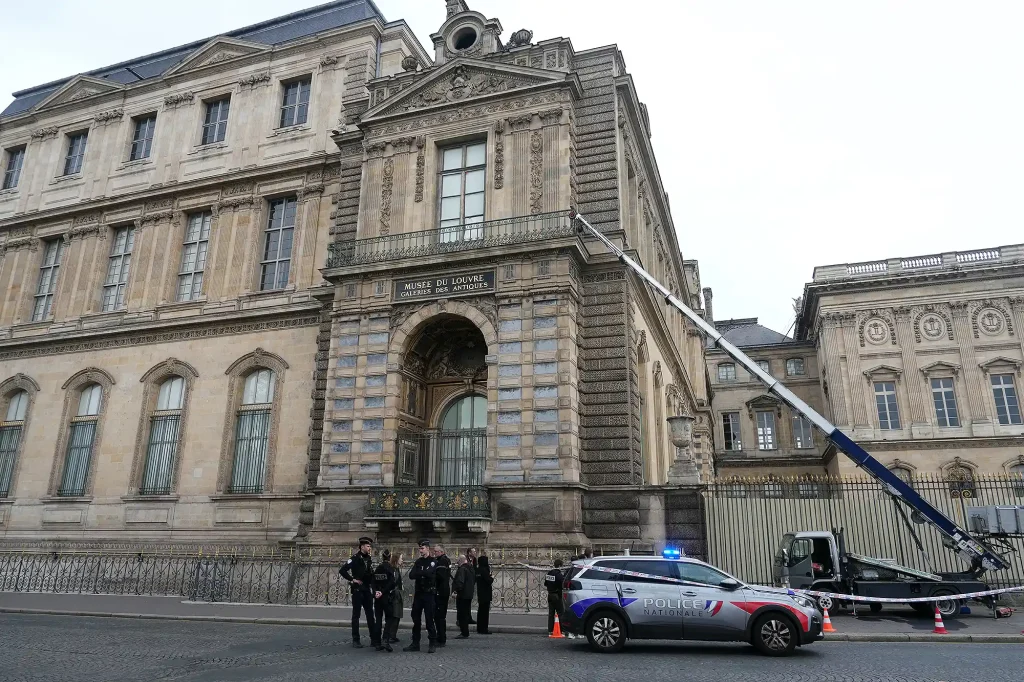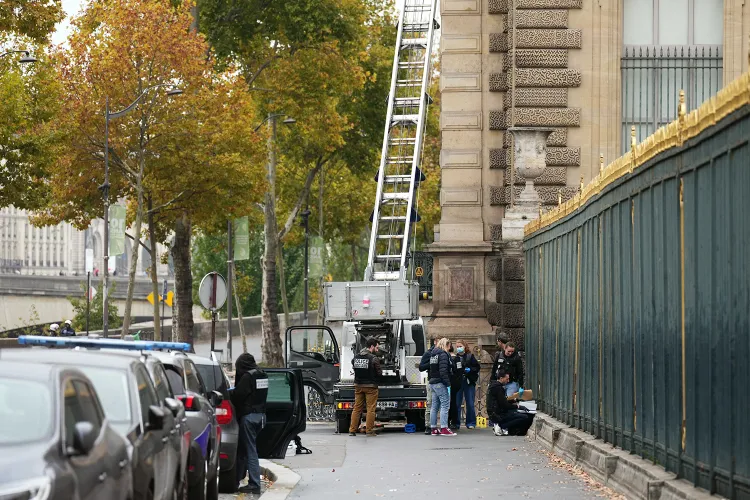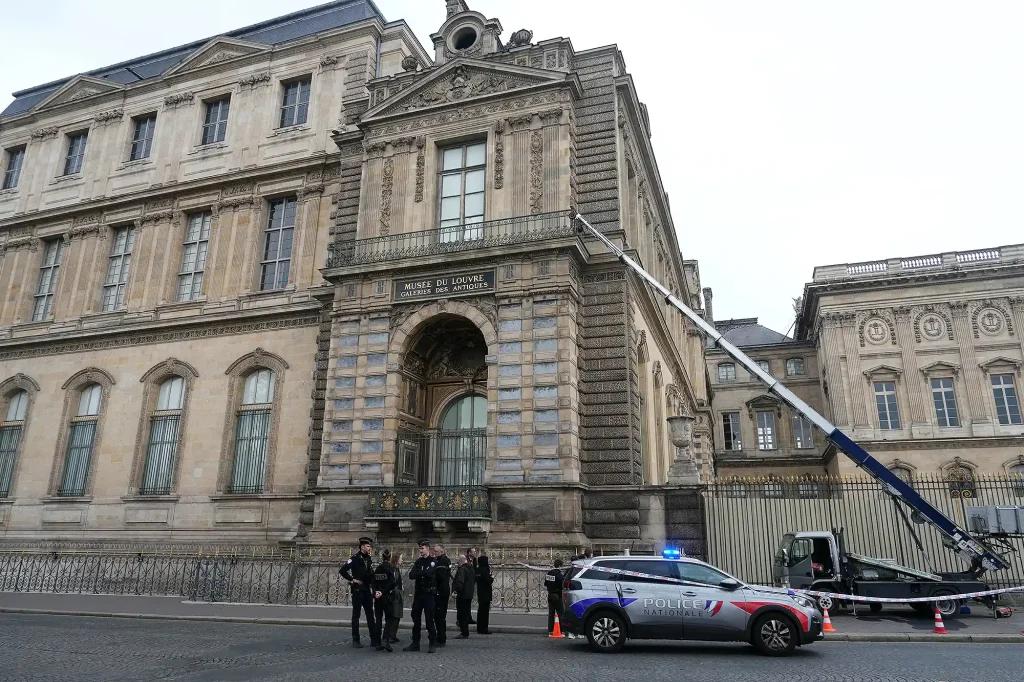The Security Flaws Behind the Louvre’s $100 Million Jewel Heist: How a Simple Password and Camera Blind Spots Led to Paris’ Greatest Art Crime
If there is a universal law within the hallowed, marble-clad corridors of Paris’ Louvre Museum, it is this: the treasures housed here are untouchable. For centuries, dynasties of French rulers, generations of curators, and teams of watchful guards have treated the institution’s exhibitions—iconic canvases and regal jewels—with a sense of reverence and invincibility. Yet, on the morning of October 18, 2025, that sense of safety shattered, leaving the world’s most prestigious museum and millions of art lovers stunned at the scale and audacity of a robbery that would soon dominate global headlines. In seven minutes, thieves broke in, defeated security measures, and made off with more than $100 million in crown jewels, forever changing how we see museum safety at the highest level.

What happened that crisp Paris morning was not random, haphazard, or impulsive—it was a calculated strike, orchestrated with surgical precision that suggested months, perhaps years of planning, inside knowledge, and remarkable confidence. The scene, according to investigators and eyewitnesses, unfolded on the second floor of the Louvre in the Galerie d’Apollon (the Apollo Gallery), which was open to the public. The gallery itself is an emblem of classic European culture, drenched in golden light and renowned for displaying the French Crown Jewels—pieces that symbolize centuries of history and cultural identity. As early visitors strolled through its grand halls and snapped photos, a small group of thieves prepared outside for the moment of intrusion that would stun a nation.
The break-in was nothing short of a cinematic nightmare for security experts. The suspects, later revealed by prosecutors to be a sophisticated four-person crew, used power tools—likely including chainsaws and angle grinders—to force entry through a window. This wasn’t an abandoned or dimly lit part of the museum: it was a balcony adjacent to the River Seine, steps from the gallery and notably unmonitored by standard security cameras. To gain access to this highly elevated window, the robbers utilized a mechanical ladder mounted on a vehicle—a maneuver brazen enough in itself given Paris’s bustling morning foot and vehicle traffic.
Once inside, the team moved with astonishing speed and apparent confidence, bypassing alarms and evading the attention of guards and museum workers. Footage later emerged showing the masked thieves moving “calmly” and systematically, smashing display cases and pocketing eight items—a haul with immeasurable cultural and financial worth. According to France’s Interior Minister and the museum’s official statements, the complete operation lasted as little as seven minutes, a slice of time so brief it left the museum’s extensive defenses and response protocols in a state of disbelief.

The subsequent evacuation of the museum was chaotic. Visitors were rushed out as staff scrambled to assess the theft and secure other exhibits. By the time authorities arrived in force, the suspects were already executing their meticulously organized escape, fleeing first on scooters and then cars, heading east out of the city with their historic bounty. Not a single person was injured, and remarkably, not a single visitor seems to have come face-to-face with the criminals. The entire operation was clean, professional, and ruthlessly efficient.
Yet as jaw-dropping as the details of the heist may be, what truly shocked the world was the way the thieves managed to slip past supposedly state-of-the-art security. News soon surfaced that the only camera installed outside the Apollo Gallery was pointed away from the window where the criminals entered and exited. No footage of the actual entry exists. Even more concerning was the revelation, confirmed by museum insiders and widely reported in French and international media, that the password for the Louvre’s security system was simply “Louvre.” This glaring vulnerability was reportedly in use at the time of the heist, and had been flagged as a risk by France’s National Cybersecurity Agency in a 2014 audit—an astonishing lapse for an institution of the Louvre’s stature.
How could a museum housing some of humanity’s most valuable artifacts rely on such a weak key to its digital defenses? The question led to a cascade of investigations, speculation, and ultimately a crisis of confidence in the museum’s leadership. The president and director of the Louvre, Laurence des Cars, was summoned before the French Senate to account for these failures. She acknowledged the “terrible failure” the incident represented, admitting that the museum’s security situation was a top priority during her tenure and that critical vulnerabilities remained despite repeated efforts at reform and improved funding. Des Cars confirmed that while surveillance and alarms in the gallery worked as intended, the real challenge lies in adapting these systems to new, ever-evolving modes of attack—a challenge that, regrettably, had not been fully met.
It did not take long for rumors to catch up with these revelations. Within days of the robbery, French detectives discovered digital forensic evidence suggesting involvement by one or more museum employees. Authorities now suspect that information about blind spots, security codes, and staff routines may have been shared with the criminals ahead of time in what appears to be a devastating inside job. The involvement of at least one security guard is now the focus of the inquiry, and Paris’s prosecutor has suggested that the heist was possibly orchestrated by an organized crime ring, perhaps even at the behest of a wealthy international collector.

The consequences for the Louvre—and for museums across Europe—have been immediate and far-reaching. Jewel cases across France were swiftly emptied, their contents transferred to secure vaults deep underground at the Bank of France, where they now reside far from public view, 85 feet beneath the historic city. Cultural institutions have rushed to revisit their own protocols, hiring experts, updating passwords, and re-training guards in the hope of preventing copycat crimes. France’s Minister of Culture has assured the public that sweeping reforms are underway, and private security consulting firms have been called in as the museum adapts to a harsh new reality: the world’s greatest treasures are now locked behind layers of digital and physical protection, and the days of unfettered public access may never fully return.
But the emotional cost of the $100 million jewel heist runs deeper. The Apollo Gallery remains closed, its once-glittering cases now empty, its windows shielded by metal barriers. Parisians mourn the loss not just for its monetary value or cultural resonance but as a violation of trust—an assault on the shared belief that certain icons and landmarks stand forever above the reach of greed and crime. Interviews with museum staff, local artists, and longtime patrons reveal a sense of heartbreak at seeing the Louvre, for centuries the world’s paragon of stewardship, exposed as fallible.
The broader public responded, first with disbelief, then with outrage and trepidation. Social media turned the robbery into a symbol of everything fragile about our cultural institutions. Commentators pointed to chronic underfunding, bureaucratic inertia, and the ease with which seasoned criminals can defeat systems deemed impregnable. The Louvre, founded upon centuries of French pride and global admiration, must now rebuild both its defenses and its reputation, reimagining what it means to safeguard the world’s cultural heritage in an era where even a password as simple as “Louvre” can usher in disaster.
Yet, in every crisis there is a lesson, and in this tragedy, perhaps a renewed vigilance will prove to be the museum’s lasting legacy. Experts say that the days following the heist have nonetheless galvanized change. Security audits at the Louvre and across France are now more thorough. Investments into technology, staff vetting, and collaboration with global law enforcement are accelerating. The museum’s leadership remains adamant: the failures exposed by the October robbery will not just be recorded; they will be catalysts for lasting improvement.
In the end, the story of the 2025 Louvre heist is not defined by what was lost, but by what it sparks—a worldwide movement to defend art, history, and cultural treasures from threats old and new. As for the jewels, their fate remains uncertain. Authorities hold out hope of recovering at least part of the haul, though most experts concede they were likely rapidly dismantled, sold, or hidden by a criminal syndicate long before news even broke. What remains is a cautionary tale for every institution entrusted with the world’s legacy: in a digital age, security is only as strong as its weakest password, and the stakes have never been higher for getting it right.



